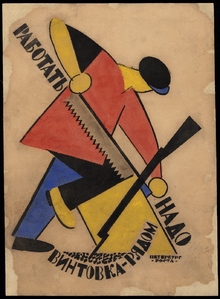Vladimir Lebedev (painter)

Vladimir Vasilyevich Lebedev — (Russian: Влади́мир Васи́льевич Ле́бедев) (14 (26) May 1891, in Saint Petersburg – 21 November 1967) was a Soviet painter and graphic artist. He became famous for his exceptional illustrations of the poems of the prominent poet and translator Samuil Marshak, such as Circus, Ice Cream, Tale About a Foolish Mouse, Moustached and Striped, Book of Many Colours, Twelve Months and Luggage.
As a young boy, Lebedev started to paint postcards that were sold in a shop in Saint Petersburg. At the age of nineteen, he held his first exhibit at the Academy of Fine Arts.[1] In 1913, he began work as a cartoonist for several satirical journals, including the famed "Satirikon" (Сатирикон). At this time he was already a prolific illustrator for the children's magazines "Jackdaw" (Галчонок), "Blue Journal" (Синий Журнал), "Everyone's Journal" (Журнал для всех), and "Argus" (Аргус). He illustrated the children's book "The Lion and the Bull" in 1917. From 1920-1922, Lebedev worked for The Russian Telegraph Agency (ROSTA) and The Department of Agitation" (Agitprop) designing propaganda posters. By the 1920s, Lebedev had friendly relations with many distinguished persons of his time, such as Tatlin, Ivan Puni, Kazimir Malevich, Vladimir Mayakovsky and the literary critic Nikolay Punin. In 1915 he married the sculptor Sarra Lebedeva.[2]
In the 1920s, Lebedev had earned the title of "King of the Children's Book." A pioneer in the field of children's illustration, he would later say on the influence of his works "I still consider to have positively influenced the creation of a new Soviet book for children, and, what is more important, this book acquired a character of its own"[3] Nikolai Punin, who wrote the first monograph on Lebedev, cited Lebedev as one of the most important illustrators of the era:
"After his brilliant experiments with "Circus" and "Ice Cream" and a number of other children's books executed by him, bookstores burst into color with numerous imitations of his examples, and book illustrations in the receding cultural tradition—all the 'World of Art' illustrations—paled in comparison, and, in terms of form, began to seem impotent, overly concerned with aesthetics, and unexpressive."[4]
In 1930s-1940s he created numerous portraits of his friends, professional models and sportsmen. He always was fond of playing sports himself. From the end of the 1930s he started to use stronger colours and thicker layers of paint, creating effects reminiscent of the works of Renoir.
As was the case with many artists and writers working under Stalinism, Lebedev ran afoul of official censorship. The book Inside the Rainbow - Russian Children's Literature 1920-35: Beautiful Books, Terrible Times offered by Dutch publishers Pegasus details threats made by Soviet authorities against Lebedev. The book was the subject of reviews in The Guardian[5] and The Financial Times,[6] among other publications.
In 2012, his work was included in an exhibit at the Museum of Modern Art.[7]
References
- ↑ "Vladimir Lebedev". Retrieved 13 June 2013.
- ↑ John Milner (1993). A Dictionary of Russian and Soviet Artists, 1420–1970. Antique Collectors' Club. ISBN 978-1-85149-182-7.
- ↑ Lemmens, Albert (2009). Russian Artists and the Children's Book, 1890-1992. Nijmegen: L.S. p. 344.
- ↑ Leving, Yuri (2011). "Mr. Twister in the Land of Bolsheviks: Sketching Laughter in Marshak's Poem". Slavic Review. 7 (2): 298.
- ↑ Pullman, Philip (11 October 2013). "How children's books thrived under Stalin". Retrieved 27 October 2016 – via The Guardian.
- ↑ "Inside the Rainbow: how Soviet Russia tried to reinvent fairytales". Retrieved 27 October 2016.
- ↑ "A century of dictating and entertaining kids – Aesthetic Perspectives". Retrieved 27 October 2016.
External links
- Biography at SOVCOM
- Biography at Artonline.ru (Russian)
- «Из истории детской иллюстрированной книги 1920-х годов» В. Петров (Russian) (examples of his children's book illustrations near the middle of the article)
- Russian Placards, 1917-1922 from Dartmouth Digital Library